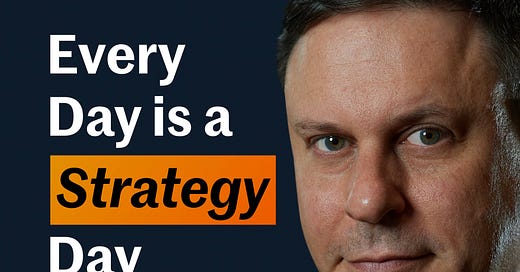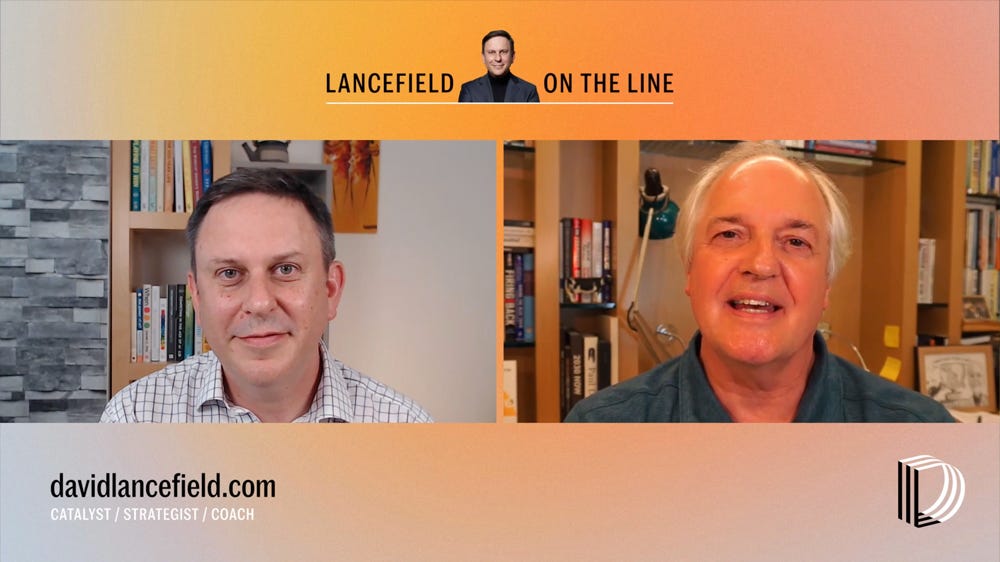How to develop your systems thinking
Seeing clearly, acting wisely, and leading where it matters most
Welcome to Every Day is a Strategy Day, where we break down strategy into something usable, memorable, and provocative.
We’re living through a range of systemic shocks, including climate change, social inequality, the impact of AI, political fragmentation, and geopolitical conflict. The question is no longer “Is this relevant to me?” but “How do I respond wisely and constructively?”
This edition helps you develop your systems thinking so you can lead with clarity and positively contribute to the systems you’re part of, from personal to planetary.
Think.
“Less bad is not good enough anymore.”, Paul Polman, former CEO of Unilever
Systems thinking is about seeing patterns, not just problems. Most challenges today, such as climate risk, AI misuse, and inequity, aren’t isolated. They’re outcomes of complex systems. Your role as a leader is to understand these systems and their interrelationships, and then determine your role within them.
Here are five interconnected systems you navigate daily.
1. Inner system: your beliefs, identity, and mindset. Think about the assumptions or fears that drive your decisions. Consider whether you’re leading your life using outdated scripts about control, success, or safety. Peter Senge calls these “mental models” — often the deepest leverage points for change. You can’t shift outer systems if your inner one is stuck.
2. Relational system: Your teams, networks, and key partnerships. Think about who shapes the unspoken rules you abide by. What’s rewarded socially, whether in agreement or challenge? Art Kleiner calls this the “core group”, the informal circle that often governs what’s possible, regardless of formal structure.
3. Organisational system: Culture, incentives, strategy, and decision-making. There’s a fascinating question of whether we set targets to win or not to lose, and whether these targets reflect our values, in other words, are they worth achieving? Paul Polman warns that many leaders still play it safe, fearing discomfort or failure. Systemic leadership means designing for integrity, not optics.
4. Technological system: The tools and algorithms shaping your work. Consider what’s being automated and amplified, primarily through AI. How does your tech augment intelligence or shortcut wisdom? Whose data are used, and who benefits? AI isn’t neutral. It embeds values and redistributes power. Leaders must interrogate what their systems optimise for and at what cost.
5. Societal & ecological system: Markets, ecosystems, norms, and public institutions. What broader systems are you entangled with and shaping in return? And most importantly, are you a bystander or a steward?
Systems don’t operate in isolation; they interact dynamically. Your tech choices impact your culture, your mindset influences your partnerships, and strategy resides in the intersections.
Systems thinkers ask: What feedback loop am I part of? And what leverage point am I ignoring?
Listen.
Listening in systems means paying attention to what’s not said, especially the truths we avoid, the targets we dilute, the power we don’t challenge.
Polman warns against reputational caution masquerading as strategy. He calls for bolder, science-aligned, uncomfortable action even when the path isn’t clear. “If you’re silent or turn your back, you become complicit.”
Listen to my conversation with Polman here.
Visualise.
When you’re stuck, it’s often because you see too little of the system.
Draw five rings:
Inner → Relational → Organisational → Technological → Societal & Ecological
Put a complex issue you’re grappling with in the middle.
For each ring, ask:
What forces are at play?
Where are the loops or bottlenecks?
What’s missing from your current view?
This is a diagnostic tool. Its power lies in surfacing dynamics you usually ignore and starting to see your challenge in context.
Read.
📘 The Fifth Discipline – Peter Senge. A masterwork on systems thinking and learning organisations. Senge introduces powerful tools for working with feedback loops, mental models, and long-term change.
📘 Net Positive – Paul Polman & Andrew Winston. A bold call for companies to go beyond “doing less harm” and start giving more than they take, with practical stories and frameworks for how.
📘 Who Really Matters - Art Kleiner. Explores how influence works behind the scenes in organisations and how to align informal power with meaningful change.
📘 Thinking in Systems – Donella Meadows. An essential introduction to systems behaviour, from leverage points to unintended consequences.
📘 The Systems Work of Social Change – Rayner & Bonnici. Case studies and insights on shifting social systems through embedded leadership, collaboration, and equity-first strategy.
Challenge yourself.
Now that you’ve mapped the system, what’s your next move?
Identify one system where:
You’re unintentionally sustaining the issue.
You have more influence than you’ve been using.
A slight shift could ripple across the others.
Ask:
Where am I complicit?
Who else could I partner with to shift this?
What would bold but proportionate action look like?
This is how you build systems leadership: acting with humility, awareness, and intention, even when you are uncomfortable.
You’re not outside the system. You’re shaping it in every meeting, message, and metric you touch.
Final word
You can’t control these systems, but you're never powerless inside them.
The more you see, the more wisely you can act.
Because every day is a strategy day, especially in a world that needs more courageous systems thinkers.
Warmly,
David.
***
That’s all for this edition. Thanks for your interest, encouragement, and inspiration.
Subscribe for free to receive new posts and support my work:






Great post, David. Strong mental models paired with systems thinking is really the only path forward for the leader/CEO. Complexity and pace of change have reached the point that they are requirements, not nice-to-haves.